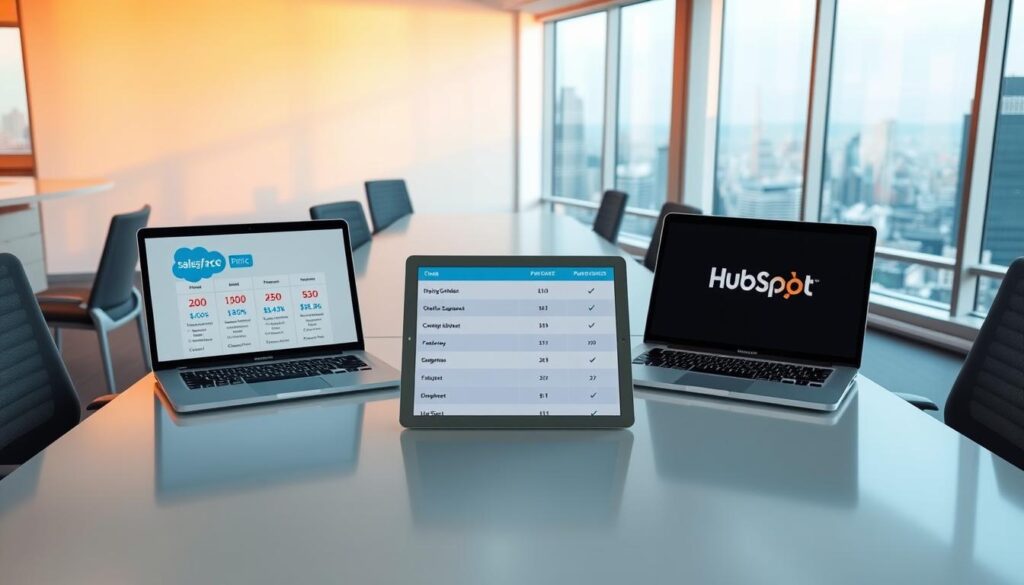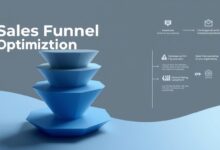Salesforce vs HubSpot: The Best CRM for Your Needs
Choosing the right customer relationship management platform can make or break your business growth. Two industry-leading tools dominate this space, each offering unique features tailored to different organizational goals. Whether you need to streamline sales pipelines, automate marketing workflows, or unify team collaboration, understanding their core strengths is essential.
One solution began as a marketing-focused software before expanding into a full CRM suite, prioritizing user-friendly design for growing teams. The other started as a sales automation powerhouse, later building robust tools for complex enterprise needs. Both platforms now deliver versatile ecosystems supporting everything from project management to data analytics.
This guide breaks down how these business solutions evolved to serve distinct purposes. You’ll learn why startups often favor one platform’s simplicity, while larger companies might prefer the other’s customization depth. We’ll compare pricing models, integration capabilities, and scalability factors to help you align your choice with long-term objectives.
Key Takeaways
- Understand how each platform’s origin story shapes its current capabilities
- Identify which solution matches your company’s size and growth trajectory
- Compare core strengths in marketing automation versus sales pipeline management
- Evaluate scalability options for evolving customer engagement needs
- Discover hidden costs and implementation considerations for both tools
Introduction to CRM Solutions for Modern Businesses
Businesses today rely on advanced tools to keep up with evolving customer expectations. Managing interactions across emails, social media, and live chats requires a centralized platform. This is where customer relationship management systems shine—they turn chaotic workflows into organized, actionable strategies.
Modern CRMs do more than store contact details. They automate repetitive tasks like follow-up emails or lead scoring, freeing teams to focus on high-impact work. Real-time dashboards show which customer segments need attention, helping companies prioritize effectively.
Two popular approaches dominate the market. One solution combines marketing and sales processes in a single interface, ideal for collaborative teams. The other offers deep customization for complex sales pipelines, appealing to larger organizations. Both aim to strengthen business relationships through data-driven insights.
| Feature | Core Purpose | Key Benefit |
|---|---|---|
| Centralized Data | Unify customer interactions | Eliminate data silos |
| Automation | Reduce manual work | Boost team efficiency |
| Analytics | Track performance metrics | Improve decision-making |
Choosing the right system depends on your company’s size and goals. Small businesses might prefer intuitive setups that require minimal training. Enterprises often need robust customization to align with existing management systems. Either way, the goal remains the same: build lasting customer connections that drive growth.
Salesforce vs HubSpot: A Quick Comparison
Modern teams need tools that bridge sales and marketing without complicating workflows. Both platforms deliver core CRM features, but their methods for unifying these functions reveal distinct advantages. Let’s explore how each solution structures its offerings.
Key Features at a Glance
While both tools cover essentials like contact management and analytics, their packaging differs. One bundles marketing sales tools into every tier, including email automation and social media scheduling. The other prioritizes advanced pipeline customization, requiring add-ons for full marketing integration.
| Feature | Core Offering | Access Tier |
|---|---|---|
| Email Campaigns | Built-in templates | Free plan available |
| Sales Forecasting | AI-driven predictions | Premium packages |
| Marketing Automation | Basic workflows | Starter plans |
| Custom Reporting | Drag-and-drop builder | Enterprise tier |
Overview of Sales and Marketing Capabilities
Teams wanting immediate sales process alignment with marketing efforts often prefer all-in-one bundles. These plans include lead scoring and VoIP integrations from day one. For companies needing phased rollouts, modular systems allow separate scaling of sales tools and campaign managers.
Smaller businesses benefit from pre-connected workflows that sync data across departments automatically. Larger organizations might value tailoring each module to specific teams, even if setup takes longer. The right choice depends on whether you prioritize speed or precision in your marketing sales strategy.
Detailed Feature Comparison and Core Differences
When evaluating CRM platforms, three critical areas often determine the best fit: predictive analytics, campaign execution, and system adaptability. Let’s break down how leading solutions stack up in these key features.
Sales Forecasting and Data Insights
One platform shines with built-in predictive analytics that calculate conversion odds using historical data patterns. Its contact scoring models update in real time, helping teams prioritize high-value leads. The other offers drag-and-drop reporting tools, letting users visualize sales pipelines without technical expertise.
Automated Campaign Execution
For marketing automation, the choice depends on your team’s technical skill. One system provides pre-built email sequences tied to social media scheduling and SEO optimization. The other requires third-party integrations for advanced campaign tools but delivers superior A/B testing granularity.
Tailoring Your Workflow
Customization needs separate these platforms clearly. Developers favor one for its open API and modular app ecosystem supporting complex processes. Marketers often prefer the other’s no-code editors that adjust forms and landing pages in minutes.
| Feature Area | Platform A Strengths | Platform B Strengths |
|---|---|---|
| Sales Forecasting | AI-driven predictions | Real-time dashboards |
| Marketing Tools | PPC/SEO integration | Advanced A/B testing |
| System Flexibility | Custom code support | Visual workflow builders |
Your choice hinges on whether you value depth in analytics or ease in campaign management. Teams needing granular control over sales data might lean one way, while those prioritizing email marketing efficiency could prefer the other. Both platforms scale effectively but demand different implementation strategies.
Ease of Use and Onboarding Experience
Navigating a new CRM platform should feel like a guided tour, not a maze. Both tools offer robust onboarding resources but take different paths to get teams up to speed. The right choice depends on whether your team values step-by-step handholding or prefers exploring features independently.
Intuitive Interface and Guided Setup
One platform greets users with milestone checklists that outline setup tasks in clear stages. Its dashboard groups tools into labeled hubs, making it easy to locate email templates or analytics. New users report feeling confident within hours thanks to progress trackers and tooltip explanations.
In-Depth Demos and Learning Curve
The other solution provides comprehensive demo environments showcasing advanced data management tools. While powerful, its modular design requires learning multiple apps for sales tracking versus campaign creation. Teams often need 2-3 weeks to master navigation but gain precision in custom workflows.
| Feature | Guided Platform | Modular Platform |
|---|---|---|
| Setup Guidance | Interactive checklists | Self-paced tutorials |
| Interface Design | Unified dashboard | App-based navigation |
| Implementation Time | 36-day average | 17-day average |
Surprisingly, the steeper learning curve doesn’t always mean slower deployment. Proper planning helps teams leverage detailed documentation to configure complex processes quickly. Meanwhile, guided systems reduce initial confusion but may require later adjustments as needs evolve.
Customization and Integration Capabilities
Tailoring your CRM to fit unique workflows separates good systems from game-changers. Modern platforms offer two paths: limitless code-based adjustments or curated plug-and-play expansions. Your choice depends on whether you need surgical precision or streamlined simplicity.
Custom Coding and Developer Tools
One platform dominates complex customization with browser-based coding environments. Developers build tailored solutions without local software using integrated tools like Code Builder. This modular approach lets enterprises stitch together specialized tools like digital LEGO blocks.
Another solution keeps things accessible with JavaScript/Python scripting for workflow tweaks. GitHub integration simplifies version control, while pre-built templates handle common automation tasks. Teams without coding experts appreciate this balanced approach to customization.
App Ecosystem Showdown
App marketplaces determine how easily you expand core features. The industry leader boasts over 5,000 integrations through its AppExchange – a wide range covering niche industry needs. Each listing undergoes rigorous security checks, though navigation requires technical know-how.
Its competitor’s curated marketplace offers 1,800+ vetted apps with transparent pricing and implementation guides. Filtering by use case or department helps non-technical users find solutions quickly. Both platforms connect to Zapier, bridging gaps with external data sources.
| Feature | Enterprise Platform | Growth-Focused Platform |
|---|---|---|
| Total Integrations | 5,000+ | 1,800+ |
| App Discovery | Advanced filters | Use-case categories |
| Implementation | Developer-guided | DIY tutorials |
Pricing Structures: HubSpot vs Salesforce Explained
Budgeting for CRM tools requires balancing upfront costs with long-term value. Two distinct approaches emerge in the market – one favoring accessible entry points, the other offering premium enterprise packages. Let’s examine how these models serve different organizational needs.

Breakdown of Sales Hub Pricing
The growth-focused platform starts with a free plan covering core CRM features and basic marketing tools. Paid tiers begin at $20 monthly per user, scaling to $150 for advanced enterprise capabilities. Each tier bundles sales automation with customer service tools, maintaining predictable billing as teams expand.
Understanding Sales Cloud Costs
Enterprise-grade solutions use modular pricing, starting at $25 monthly per user for basic pipeline management. Separate marketing packages begin at $1,250 monthly, making integrated workflows costly for smaller teams. However, large organizations often save through bundled suite discounts unavailable in entry-level plans.
While startups appreciate transparent tiered models, scaling companies might prefer customizable packages. Always calculate per-user expenses alongside required add-ons to avoid budget surprises. The right plan aligns with both current needs and projected growth milestones.
AI and Automation: Harnessing Intelligent Features
Artificial intelligence transforms how teams engage customers through smarter workflows. Modern platforms now embed predictive analytics and auto-generated content directly into their core features. These advancements help businesses streamline repetitive tasks while personalizing interactions at scale.
Enterprise-Grade Customization
One leader in AI-driven automation offers tiered intelligence tools that grow with your budget. Its system builds custom agents for lead scoring and sales coaching, complete with compliance safeguards. Developers appreciate the granular control over how AI enhances email campaigns and data analysis.
Accessible Intelligence for Growth
Another platform prioritizes ready-to-use tools with chatbots baked into CMS and marketing hubs. Users activate pre-trained AI assistants for social media or customer service through simple toggle switches. The interface suggests optimizations in real time, reducing the learning curve for new teams.
Your choice hinges on technical resources versus speed-to-value. Complex organizations benefit from deeply customizable capabilities, while growing businesses often prefer AI that works out of the box. Both approaches demonstrate how intelligent automation reshapes modern marketing strategies.
FAQ
Which platform is better for small businesses?
HubSpot’s free CRM and affordable starter plans make it ideal for smaller teams. Salesforce offers more advanced tools but often suits larger enterprises due to higher costs and complexity.
Can I integrate third-party apps with these tools?
Yes! Both platforms support integrations via app marketplaces and APIs. Salesforce’s ecosystem is more extensive, while HubSpot focuses on seamless native app connectivity.
How do AI features compare between the two?
Salesforce Einstein provides deep analytics for forecasting, while HubSpot Breeze simplifies tasks like email drafting with user-friendly AI designed for non-technical users.
Which option has better marketing automation?
HubSpot excels in unified marketing workflows, including email and social media. Salesforce offers robust campaign management but may require extra setup for advanced automation.
Is customization easier on one platform?
Salesforce allows highly tailored workflows with custom coding, ideal for complex needs. HubSpot offers intuitive drag-and-drop editors for faster, simpler adjustments.
What’s the biggest difference in pricing models?
HubSpot uses tiered plans with transparent per-user costs. Salesforce pricing scales based on features and user count, often requiring custom quotes for enterprise packages.
Which tool has a shorter learning curve?
HubSpot’s clean interface and guided setup help teams start quickly. Salesforce demands more training due to its depth, but offers detailed demos for onboarding.









